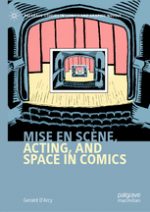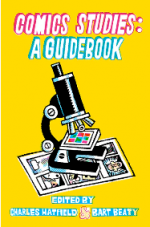Im Monitor werden in unregelmäßigen Abständen aktuelle Publikationen aus den letzten 6 Monaten vorgestellt, die für die Comicforschung relevant sein könnten. Die kurzen Ankündigungstexte dazu stammen von den jeweiligen Verlagsseiten. Haben Sie Anregungen oder Hinweise auf Neuerscheinungen, die übersehen worden sind und hier erwähnt werden sollten? Das Team freut sich über eine Mail an redaktion@comicgesellschaft.de.
→ Zu früheren Monitoren.
 Leiji Matsumoto: Essays on the Manga and Anime Legend
Leiji Matsumoto: Essays on the Manga and Anime Legend
Helen McCarthy, Darren-Jon Ashmore (Hgs.)
McFarland
206 Seiten
Oktober 2020
Verlagsseite
„Leiji Matsumoto is one of Japan’s most influential myth creators. Yet the huge scope of his work, spanning past, present and future in a constantly connecting multiverse, is largely unknown outside Japan. Matsumoto was the major creative force on Star Blazers, America’s gateway drug for TV anime, and created Captain Harlock, a TV phenomenon in Europe. As well as space operas, he made manga on musicians from Bowie to Tchaikovsky, wrote the manga version of American cowboy show Laramie, and created dozens of girls’ comics. He is a respected manga scholar, an expert on Japanese swords, a frustrated engineer and pilot who still wants to be a spaceman in his eighties.
This collection of new essays—the first book on Matsumoto in English—covers his seven decades of comic creation, drawing on contemporary scholarship, artistic practice and fan studies to map Matsumoto’s vast universe. The contributors—artists, creators, translators and scholars—mirror the range of his work and experience. From the bildungsroman to the importance of textual analysis for costume and performance, from early days in poverty to honors around the world, this volume offers previously unexplored biographical and bibliographic detail from a life story as thrilling as anything he created.“
 Mise en Scène, Acting, and Space in Comics
Mise en Scène, Acting, and Space in Comics
Geraint D’Arcy
Palgrave
146 Seiten
August 2020
Verlagsseite
„This book explores some of the less frequently questioned ideas which underpin comics creation and criticism. “Mise en scène” is a term which refers to the way in which visual elements work together to create meaning in comics. It is a term that comics have borrowed from cinema, which borrowed it in turn from theatre. But comics are not film and they are not cinema, so how can this term be of any use? If we consider comics to have mise en scène, should not we also ask if the characters in comics act like the characters on film and stage? In its exploration of these ideas, this book also asks what film and theatre can learn from comics.“
 Critical Directions in Comics Studies
Critical Directions in Comics Studies
Thomas Giddens (Hg.)
University Press of Mississippi
146 Seiten
August 2020
Verlagsseite
„Recent decades have seen comics studies blossom, but within the ecosystems of this growth, dominant assumptions have taken root—assumptions around the particular methods used to approach the comics form, the ways we should read comics, how its “system” works, and the disciplinary relationships that surround this evolving area of study. But other perspectives have also begun to flourish. These approaches question the reliance on structural linguistics and the tools of English and cultural studies in the examination and understanding of comics.
In this edited collection, scholars from a variety of disciplines examine comics by addressing materiality and form as well as the wider economic and political contexts of comics’ creation and reception. Through this lens, influenced by poststructuralist theories, contributors explore and elaborate other possibilities for working with comics as a critical resource, consolidating the emergence of these alternative modes of engagement in a single text. This opens comics studies to a wider array of resources, perspectives, and modes of engagement.
Included in this volume are essays on a range of comics and illustrations as well as considerations of such popular comics as Deadpool, Daredevil, and V for Vendetta, and analyses of comics production, medical illustrations, and original comics. Some contributions even unfold in the form of comics panels.
Contributions by Paul Fisher Davies, Lisa DeTora, Yasemin J. Erden, Adam Gearey, Thomas Giddens, Peter Goodrich, Maggie Gray, Matthew J. A. Green, Vladislav Maksimov, Timothy D. Peters, Christopher Pizzino, Nicola Streeten, and Lydia Wysocki.“
 Comic Art in Museums*
Comic Art in Museums*
Kim A. Munson (Hg.)
University Press of Mississippi
400 Seiten
Juli 2020
Verlagsseite
„Through essays and interviews, Kim A. Munson’s anthology tells the story of the over-thirty-year history of the artists, art critics, collectors, curators, journalists, and academics who championed the serious study of comics, the trends and controversies that produced institutional interest in comics, and the wax and wane and then return of comic art in museums.
Audiences have enjoyed displays of comic art in museums as early as 1930. In the mid-1960s, after a period when most representational and commercial art was shunned, comic art began a gradual return to art museums as curators responded to the appropriation of comics characters and iconography by such famous pop artists as Andy Warhol and Roy Lichtenstein. From the first-known exhibit to show comics in art historical context in 1942 to the evolution of manga exhibitions in Japan, this volume regards exhibitions both in the United States and internationally.
With over eighty images and thoughtful essays by Denis Kitchen, Brian Walker, Andrei Molotiu, Paul Gravett, Art Spiegelman, Trina Robbins, and Charles Hatfield, among others, this anthology shows how exhibitions expanded the public dialogue about comic art and our expectation of “good art”—displaying how dedicated artists, collectors, fans, and curators advanced comics from a frequently censored low-art medium to a respected art form celebrated worldwide.
Contributions by Kenneth Baker, Jaqueline Berndt, Albert Boime, John Carlin, Benoit Crucifix, David Deitcher, Michael Dooley, Damian Duffy, M. C. Gaines, Paul Gravett, Diana Green, Karen Green, Doug Harvey, Charles Hatfield, M. Thomas Inge, Leslie Jones, Jonah Kinigstein, Denis Kitchen, John A. Lent, Dwayne McDuffie, Andrei Molotiu, Alvaro de Moya, Kim A. Munson, Cullen Murphy, Gary Panter, Trina Robbins, Rob Salkowitz, Antoine Sausverd, Art Spiegelman, Scott Timberg, Carol Tyler, Brian Walker, Alexi Worth, Joe Wos, and Craig Yoe.“
 Comics Studies: A Guidebook*
Comics Studies: A Guidebook*
Charles Hatfield, Bart Beaty (Hgs.)
Rutgers University Press
336 Seiten
August 2020
Verlagsseite
„In the twenty-first century, the field of comics studies has exploded. Scholarship on graphic novels, comic books, comic strips, webcomics, manga, and all forms of comic art has grown at a dizzying pace, with new publications, institutions, and courses springing up everywhere. The field crosses disciplinary and cultural borders and brings together myriad traditions. Comics Studies: A Guidebook offers a rich but concise introduction to this multifaceted field, authored by leading experts in multiple disciplines. It opens diverse entryways to comics studies, including history, form, audiences, genre, and cultural, industrial, and economic contexts. An invaluable one-stop resource for veteran and new comics scholars alike, this guidebook represents the state of the art in contemporary comics scholarship.“
*Die ComFor-Redaktion bedauert den Mangel an Diversität in dieser Publikation. Wir sind bestrebt, möglichst neutral über das Feld der Comicforschung in all seiner Breite zu informieren und redaktionelle Selektionsprozesse auf ein Minimum zu beschränken. Gleichzeitig sind wir uns jedoch auch der problematischen Strukturen des Wissenschaftsbetriebs bewusst, die häufig dazu führen, dass insbesondere Comicforscherinnen sowie jene mit marginalisierten Identitäten weniger sichtbar sind. Wir wissen, dass dieses Ungleichgewicht oft nicht der Intention der Herausgeber_innen / Veranstalter_innen entspricht und möchten dies auch nicht unterstellen, wollen aber dennoch darauf aufmerksam machen, um ein Bewusstsein für dieses Problem zu schaffen.